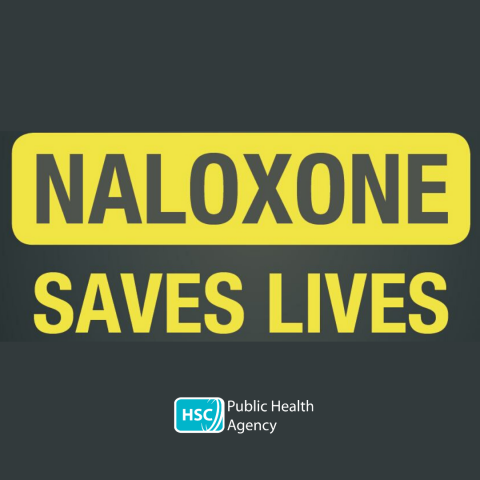Take Home Naloxone reverses more than 200 overdoses

New figures from the Public Health Agency (PHA) show that the Take Home Naloxone programme has seen naloxone administered 240 times in 2018-19 and has been successful in reversing an opiate overdose in over 90% of cases.
Naloxone, supplied in a small syringe, is injected intramuscularly and can be administered by anyone in an emergency overdose situation. Over the past five years, Take Home Naloxone has been successful in reversing 435 opiate overdoses.
The Public Health Agency, with support from the Health and Social Care Board, coordinates the Take Home Naloxone programme.
Michael Owen, the PHA’s Lead for Drugs and Alcohol, said: “As the figures show, this service provides an important life-saving intervention – each overdose reversal is an occasion when a person could have died, but didn’t.
“While only a very small portion of the population here uses heroin or other opiate type drugs, those who do are at a high risk of illness or death.
“It is therefore important that we look at ways that we can reduce the danger that these people face. The main risks for people who use opiates are accidental overdose, and the transmission of blood-borne viruses through sharing of injecting equipment.
“We need to ensure we do all we can to reduce these dangers, by ensuring access to needle exchange services with trained staff, and providing access to the life-saving drug naloxone.
“Addressing these risks also provides opportunities for health service engagement with this hard-to-reach group, which can be used to support them into treatment.”
Naloxone is an opioid antagonist, which temporarily and rapidly reverses the effects of heroin and other opioids. Following overdose by heroin injection, death typically occurs within one to three hours, limiting the window of opportunity to intervene.
Most drug overdose deaths occur in the company of other people, with up to three-quarters of overdoses being witnessed by others. Supplying Take Home Naloxone and training to people within the opioid-using community can be an effective lifesaving intervention.
In 2016-17, Take Home Naloxone was supplied 271 times; in 2017-18 it was supplied 807 times, and in 2018-19 it was supplied 1,332 times.
Michael continued: “While anecdotally we are being made aware of an increase in the number of people injecting substances, we would have expected to see an increase in the number of times naloxone has been administered anyway, as there have been changes in legislation in recent years which have made it possible for the PHA to fund Low Threshold Outreach Services to supply naloxone to their clients, and also for naloxone to be supplied not just to individuals at risk but also to anyone who comes into contact with individuals at risk, for example their families or staff who work in homeless hostels.”
In 95 cases the use of other drugs, besides heroin, was reported. In 90 of these cases the patient survived.
Where the use of other drugs was reported, the most common other drugs were benzodiazepines (41% of cases where other drug use was reported) and Pregabalin (28% of cases where other drug use was reported).
Details on how to access the services that provide the Take Home Naloxone programme can be found on www.drugsandalcoholni.info
The 2018-19 Annual report on the supply and use of Take Home Naloxone can be found at www.pha.site/NaloxoneReports
Notes to editors:
- During the period between 1 April 2018 and 31 March 2019, Naloxone was administered on 240 occasions and in 92% of these cases the patient survived. Please note these are numbers of occasions naloxone was used, not the number of unique individuals to whom it was administered.
- In 95 cases the use of other drugs (besides heroin) was reported; in 90 of these cases the patient survived.
- Where the use of other drugs was reported, the most common other drugs were benzodiazepines (41% of cases where other drug use was reported) and Pregabalin (28% of cases where other drug use was reported).
- In 155 cases, the person who overdosed was male, in 77 cases they were female, and in eight cases gender was not recorded.
- The Take Home Naloxone programme has been in operation in Northern Ireland since 2012 and since then more than 3,145 packs have been supplied.
- The programme is coordinated by the Public Health Agency, with support from the Health and Social Care Board. Packs are supplied by staff within individual Health and Social Care Trusts, the Prison Service and voluntary sector drug treatment services. Service User representatives have also played a major role in providing advice, support and training.
- The PHA currently funds Extern to provide opioid overdose response training (CPR and administering Take Home Naloxone), to enable appropriate individuals to provide the training to those at risk.
Take Home Naloxone packs are funded by the Public Health Agency and supplied through the Low Threshold Outreach Services.
Organisations who deliver the Take Home Naloxone programme:
- Belfast Drug Outreach Team
- Belfast HSCT Community Addiction Team
- South Eastern area Community Addiction Teams
- Belfast Inclusion Health Service
- Northern area Community Addiction Service
- Southern area Community Addiction Team
- Western area Community Addiction Teams
- Extern (Northern and Southern areas)
- Simon Community (South Eastern Area)
- Depaul (in Western area)
- ARC Healthy Living Centre (Western area);
- First Housing (Western area)
